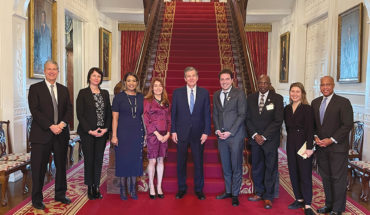by Dean King
photographs by Missy McLamb
Victor and Sarah Lytvinenko, creators of Raleigh Denim, international fashion world upstarts, oh, and husband and wife, are in sync.
They work together. They play together. They jet together – New York, L.A., Hong Kong, Tokyo. And while they venture afar and among the fabulous, the native Raleigh duo, both 32 and beacons of the capital city’s hip downtown scene, are breathing fresh life into an industry as old and venerable as the state, one that until now had faded like old dungarees.
It’s Friday afternoon. Inside the Lytvinenkos’ renovated warehouse workshop and retail space on West Martin Street, as workers wrap up another week of making artisanal blue jeans, there’s the kind of unmistakable camaraderie that comes from people working successfully together, in sync, like their company’s founders. As Rosando Antigua Linares, “the pocket guy,” cleans lint from the sewing stations with an air compressor, various workers, stationed at a slew of task-specific sewing machines, stitch belt loops, bar tacks, or three-piece waistbands, and visit with one another. The day before, they’d shared a potluck feast for their “family” lunch on a long table astride the workspace. Chris Ellsberg, the 79-year-old German master pattern maker, brought chocolate birthday cake for Rich Larson, the warehouse manager. Linares brought rice and beans, chain-stitcher Terry Simpson chicken casserole, and Elizabeth Ayala, who sews, tres leches cake.
By any measure, Raleigh Denim, which has just 30 employees and produces no more than 300 pairs of pants a week, is no ordinary jeans factory. A fashion world darling since Barney’s, the trend-setting Manhattan department store, put them on the map with an order of 114 pairs of jeans in 2008, Raleigh Denim and its “small batch” jeans have been touted by the likes of Elle, GQ, WWD, and The New Yorker (not to mention fashionista rags such as Foam, Creem, and Nylon.)
Last fall, Raleigh Denim opened a flagship boutique, designed by the international design firm OMA (which also did the Prada Store in NYC and the Coach Store in Tokyo), on Elizabeth Street in Manhattan’s Nolita (North of Little Italy) neighborhood.
Its success owes partly to the fact that its sporty bohemian founders, who look alike and sometimes finish each other’s sentences, are firmly grounded in their holistic vision and see jeans not just as a product but a way of life.
“It may be naïve,” Victor says. “But I want to believe that if we make clothes that are better, we can make people better.”
Together, he and Sarah have brought American jeans-making, now largely an overseas affair, back to the United States, stripped it down to its roots, applied their own Zen-like sensibility, and created what they proudly claim to be the blue jeans with “the lowest carbon footprint on earth.”
 Tag-team creativity
Tag-team creativity
By vote, the employees have decided to work an extra half hour each day to have Friday afternoons off, so at 3 p.m. the manufacturing floor closes (though the retail shop in front, The Curatory, stays open until 6 p.m.). Peace now reigns among the huge bolts of fabric, brown paper patterns, dollies loaded with jeans parts, and the 50 sewing machines, which look like a selection of Darwinian survivors, each with its own evolutionary specialty. But for the Lytvinenkos, the creative work goes on.
“On a daily basis, Victor puts out more production and operations fires, filling orders, fixing machines kind of fires,” Sarah says. “And I put out more retail, store, design, sewing-sample kind of fires.
“We’re trying very hard to overlap a little more,” she adds. “We want to put out the design fires together.”
In a closet in the back of the manufacturing space, Victor pulls a pair of old jeans from a shelf. “These are from the first batch we made that went to Barney’s,” he says. “The owner is a professor, a friend of mine and an avid cycler.”
The seat of the oft-used and mended pants is quaintly stitched in every conceivable direction. Victor gazes on them with admiration, the physical evidence of a life well lived and a pair of jeans that went on to adventure, purpose, and realized potential.
Nearby, Sarah holds up blue-gray color chips – one barely distinguishable from the next – and intently examines them, as if to detect their true nature, nuances, and connotations.
“We’re trying to get creative right now,” she says. “It’s time to be knee-deep in designing for spring ’14, and thinking about designs for fall ’14. It’s pretty simple really. Something we find in the world inspires us. We use that as a jumping-off point, in terms of color and theme and form.” Once they pick a palette, they source materials, and then, very scientifically, they “play around with them.
“I think my design sensibility, I’m learning, is actually a little bit –I don’t know what the right word is – librarianish, or preppier than I ever thought it would be, which is a funny thing to realize, and also kind of exciting to identify the things that really interest me.” Sarah says. “I just tend to like really structured, kind of buttoned up.”
“Once we identify where we want to start and what color – color is super important – then it’s very hands on,” she says, “testing patterns and tweaking bits ’til we get the right thing.”
How Victor, a wiry, brown-eyed soccer enthusiast of Ukrainian descent, and Sarah (Yarborough), a girl-next-door beauty with long brown locks and hippie roots, came to make jeans together is a tale as organic as their denim. Soft-spoken and urbane, they have followed their mutual whims and instincts, a path with twists and turns that have all played a role in their creative and entrepreneurial success. Naturally, it all started with a great Southern romance.
She went to St. Mary’s School, he to Enloe High. His brother had tickets to see Miss Saigon at the Performing Arts Center. Sarah and Victor had met briefly six months earlier and had not spoken since. He called her sheepishly. The show happened to be on her 18th birthday, but on a hunch she accepted anyway. He cooked her dinner. After the show, they got ice cream and climbed the bell tower on the N.C. State campus, near the design school. “He had really nice soccer legs,” she says. They were both hooked.
But before they started producing clothes together, they had roads to travel.
Victor thought he wanted to be a chef. While earning an undergraduate business degree at N.C. State, where he played soccer for a semester, he apprenticed at Second Empire in Raleigh. He became the fish cook in eight months and leaped to Nobu, the renowned Japanese restaurant in Manhattan. This dream ended, however, with 9/11, which briefly shut down the restaurant. Victor found himself playing semi-pro soccer for the next few years in El Salvador and Switzerland. (“More semi than pro,” he laughs.)
Sarah, whose parents had arrived in Raleigh in a VW microbus when she was a tyke – and then lived in it for the first few months in town – did stints at New York University and N.C. State, and also took to the road, cycling with her brother from Finland to Prague and then hitchhiking with a friend through Croatia.
In 2007, Victor, then 26, returned from Switzerland and looked for a replacement for a favorite pair of jeans he had worn out. He wanted tailored but comfortable jeans but could not find any. So he took his apart at the seams to see if he could make his own. Sarah, who by now had undergraduate fashion studies under her belt as well as a stint studying textiles at Penland School of Crafts in Western North Carolina, offered to help. They brainstormed on making the perfect pair of jeans.
Victor had long been intrigued by clothes. “They are the first impression we give every day,” he says. “They are the things that lie closest to us and touch us all the time.” When he was younger, a favorite shirt, a pair of pants, or jacket had given him comfort. He once made a jacket for his younger brother, Tim, putting a label inside that read “Super Tim” next to his brother’s heart. Tim was moved and wore the jacket all the time.
Victor and Sarah created their prototype to much acclaim. In 2008, the uncle of a friend introduced the two to a Barney’s buyer, who placed the landmark order. In addition to getting married that year, the couple set to work on their first collection on a shoestring budget.
They manhandled the large bolts of denim themselves, laid out and cut the fabric on a concrete floor, held down the pieces with cinderblocks, and stitched each pair with the specialized sewing machines they bought after selling a video camera and a bike. Sarah’s father put in hand-pressed rivets. Their moms ironed the jeans. Friends helped decipher a 60-page manual of shipping instructions and labeled, wrapped, and packed the jeans in boxes.
Barney’s re-ordered, and the next season more than doubled its initial order. Saks and Nordstrom would follow, along with high-end boutiques around the nation.
In gearing up, Victor and Sarah have benefited from the state’s history of textiles manufacturing. They bought old waist-banding machines and double-needle lock stitch machines from a Levi’s plant, the last in the country, that closed in 2005. Ellsberg, a former Levi’s employee, sought out Victor and Sarah after their second season, when her hairdresser in Durham told her about Raleigh Denim. On her third visit to Raleigh, she finally tracked them down in a nondescript warehouse on the edge of town, about a mile from where they are now. “I can’t believe there’s denim in the area,” she exclaimed. They could not afford to hire her, but she was so passionate about the work that she offered to help pro bono. With her manufacturing knowledge, she became a huge asset as they scaled up. “Patterns seem like a simple thing,” says Sarah. “But they’re not easy. She took our Frankenstein versions and cleaned them up and made them appropriate for production. She helped us ramp up.”
They freely admit that they are learning the ropes as they go. “Everything has a path and a process and a course that you should honor in terms of production,” Sarah says.
At ease
When they are not at work, Victor and Sarah live in a 1940s bungalow behind the Rialto Theater. They like to listen to music at King’s on Martin Street, or wherever guitarist Lonnie Walker (a Raleigh Denim riveter), Gross Ghost, Megafaun, or the Connells are grooving. Ashley Christensen’s Poole’s Diner started up at about the same time as Raleigh Denim, and they are mutual fans. Christensen catered the opening party at their New York boutique; Fayetteville Street’s Foundation bar set up a hanging neon-lit bar and served up special North Carolina cocktails. Victor and Sarah also like to hang out at locavore spots like Beasley’s Chicken + Honey, Humble Pie, Capitol Club 16, and the Laotian restaurant Bida Manda (the subject of Walter’s At the table feature this month).
“The community is supportive of new and independent ventures,” says Victor. “More people are actively pursuing new things. What we’re doing is an anomaly in a way, but it’s also the same as the local brewer, chocolate maker, or vintner. We like to hang out with people who make things.”
“A lot of the ideas behind slow foods and winemaking are what we apply to our manufacturing and our brand.”
It was while visiting family in the Eastern Ukraine in 2004 that Victor had developed a back-to-roots and earth-friendly ethos, which he and Sarah have successfully translated to fashion. His kin, farmers and miners, live “in the middle of nowhere.” Their life is completely organic and sustainable. It has to be. They draw their water from a well with a bucket, share a cow for milk, raise chickens and geese, dig their own potatoes, fish, and make moonshine out of bread yeast, sugar, and water. Victor’s “skin and bones” 83-year-old uncle Kolya drinks two fingers (the space between his little finger and his pointer finger, that is) of the brew at breakfast before farming all day at back-break pace.
“The first tomato of the season is the most delicious thing you’ve ever tasted because you haven’t eaten one in six months,” Victor says. “Radishes are the first thing ready to eat. I had never understood what there was to like about them. But now I know. They were the first fresh, crisp bite that anyone had had in six months.”
Recently, Raleigh Denim contracted with Lewie Parrisg, a Nashville, N.C., farmer to grow what they say is the first U.S.D.A. certified organic cotton crop in the state. The jeans made from this cotton (Jones organic; thin fit) took a year and a half from seed to boutique, all within 200 miles of the shop.
Symbiosis
Raleigh Denim’s business and look are still evolving, a symbiotic process. “It makes a lot of sense for us to open another store or two at some point in time over the next couple of years,” says Victor. “But there’s no hard deadline. It was a lot of work, opening the store here, opening the store in New York. And we definitely want to spend some time focusing on the actual products and collections. But having more stores will allow us to make more products more easily.”
“It’s a little bit like Ping Pong,” says Sarah. “So we opened the store in New York, and now we need to supply it. And then once we get good at that, we’ll consider opening another store. And then we’ll have figure out how to supply it.
“We have size goals, which are a little bit arbitrary, just to keep us growing. We could double or triple and still be a fairly small denim brand. But we also want to solidify our branding. That’s part of what we’re focusing on this year. We started out in men’s denim, and we want to include a full women’s collection. So how do you make that transition? That’ll be a process. That’ll take a couple of years to really do well.”
Bet on the Lytvinenkos to do it with flair – their way and in sync – and on Raleigh Denim to continue to create long legs for the slow jeans movement.
FIELD NOTES
In the front of the Martin Street atelier, in a quirky boutique, The Curatory, the Lytvinenkos sell the various Raleigh Denim lines of jeans: straight or skinny, raw or washed, boot or tapered, each style named after a different North Carolina county. Crisp sets of hand-stitched jeans, made from denim produced in the century-old Cone Denim White Oak mill in Greensboro, are priced from $200 to $300. They await an owner to move in, to match real femurs up with the images of those bones silk-screened inside. Even I – an inveterate baggy pants wearer from prep school days – quickly realize that these form-fitting jeans are of a different order. Each pair is numbered and signed either by Victor, Sarah, or one of their master artisans most responsible for the batch. Suddenly, my baggy Levi’s feel like a brown paper bag. These are a new skin. They are deliberately left long, so that the Raleigh Denim artisans can sew their distinctive chain-stitch hem with vintage machines from the ’20 and ’40s that twist the fabric, causing it to wear at an angle, looking like a worn rope. Victor recommends not washing them for three months. -D.K.






